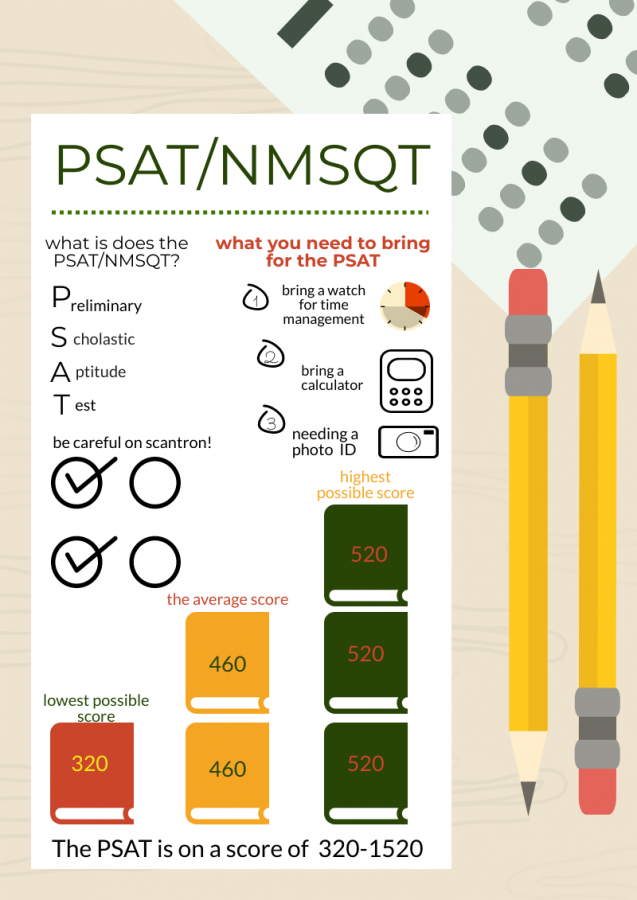WCA Sophomores and Juniors Take the PSAT
What you need to bring for the PSAT and the average scores for the PSAT.
The PSAT is designed for sophomores and juniors in high school to take for a better chance at high-quality scholarships, specifically the National Merit Scholarship, as well as to provide a benchmark to compare to future standardized test scores. Each student that is awarded the National Merit title can receive up to 2,500 dollars in scholarships, and National Merit Finalists can also receive scholarships or rewards from sponsors like corporations and colleges.
This Wednesday, Oct. 16, all of the Westminster juniors and some selected sophomores had the opportunity to take the PSAT in the Arena. Now, all they can do is wait to see their scores.
One of the selected sophomores, Izzy Trost, said, “I chose to take the PSAT, to help myself for the future exams and get a better understanding of what is coming up in the future.”
Why do people take the PSAT as sophomores? Some sophomores take the PSAT to show how serious they are about college and their future, or they may take the exam to practice the PSAT for their junior year when they will actually be considered for the National Merit Scholarship. At Westminster, the majority of sophomores and juniors are expected to sit for the exam both years.
“I took the PSAT to help myself prepare for when I have to take the PSAT junior year, and for practice in taking these kinds of tests,” said Amy Claire Godwin, another sophomore.
So, how is the PSAT scored? Similarly, but slightly different from the SAT, the College Board scores the PSAT on a scale of 320-1520. As of 2018, the average PSAT score achieved by high schoolers around the nation was a 920. The PSAT is shorter than the SAT, a college entrance exam taken by over two million students every year, and the PSAT also does not provide an essay section on the test, unlike the SAT.
The PSAT is extremely important for students who desire to achieve the National Merit Scholarship and receive recognition for their performance while the SAT is primarily used by admissions counselors at universities to determine whether an applicant is academically qualified to attend the school.
There are three main sections to the PSAT: math, reading, and writing and language. Each section has its own set time limit. For example, reading lasts for one hour, whereas math (which includes one subsection with a calculator and one without a calculator) lasts for 70 minutes. The writing and language section has a limit of 35 minutes. Overall, the PSAT takes close to three and a half or four hours including breaks. With a total of only 139 questions, the PSAT is not excessively long and provides a good starting point for high school sophomores and juniors who will soon begin preparing for either the ACT or SAT or both. The PSAT reflects the structure of the SAT in many aspects, and this is an important reason for students to take the exam, especially those who plan on using the SAT for college applications.
The PSAT can also be used to help with time management and to improve test anxiety. Unlike with the ACT and SAT, the PSAT has relatively low stakes and usually acts as more of a practice run for students to give them an idea of what standardized tests are like.
However, it is a common mistake for students to underestimate the PSAT — this preliminary test can affect one’s success on the SAT because a jump start on the PSAT gives a student an advantage in achieving a better overall score in the end.
So, should all high school students take the PSAT? Short answer: no, it is not necessary for all students to take this exam. But the long answer is that it’s likely beneficial to take the PSAT in order to be more prepared and comfortable for future standardized testing. Often, success on the ACT or SAT has more to do with a student’s mindset and ability to stay composed under pressure, and as the saying goes, “practice makes perfect.” Therefore, the more opportunities a student has to prepare (especially by participating in the PSAT), the more likely he or she is to perform well on the real college entrance exams.
For those students who do choose to take the PSAT, it’s important they are aware of the list of things they are required to bring. The test proctor will require every student to have a photo ID, No. 2 pencils with erasers, and an acceptable calculator (check with your school to see which ones are acceptable). A watch (not a smartwatch) is also suggested to assist in managing time during the exam. So, now that you know what the PSAT is and are ready to take it, take a deep breath and relax. And if you already completed the PSAT this past Wednesday and are waiting to receive your scores, hopefully, you can find relief in knowing that you did your best.




